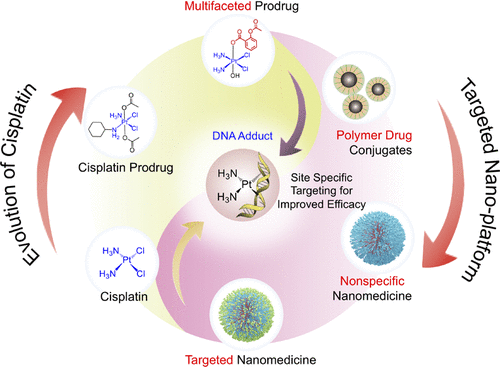当前位置:
X-MOL 学术
›
Acc. Mater. Res.
›
论文详情
Our official English website, www.x-mol.net, welcomes your
feedback! (Note: you will need to create a separate account there.)
Intersection of Inorganic Chemistry and Nanotechnology for the Creation of New Cancer Therapies
Accounts of Materials Research ( IF 14.0 ) Pub Date : 2022-03-04 , DOI: 10.1021/accountsmr.1c00178 Anuj S Shah 1 , Bapurao Surnar 2 , Nagesh Kolishetti 3 , Shanta Dhar 2
Accounts of Materials Research ( IF 14.0 ) Pub Date : 2022-03-04 , DOI: 10.1021/accountsmr.1c00178 Anuj S Shah 1 , Bapurao Surnar 2 , Nagesh Kolishetti 3 , Shanta Dhar 2
Affiliation

|
Since its discovery in 1965, the inorganic drug cisplatin has become a mainstay of cancer therapies and has inspired many platinum (Pt)-based compounds to solve various issues of toxicity and limitations associated with the original cisplatin. However, many of these drugs/prodrugs continue to be plagued by an array of side effects, limited circulation, and half-life and off-target effects. To solve this issue, we have constructed an array of platinum-based prodrugs on a Pt(IV) skeleton, which provides more favorable geometry and hydrophobicity, easier functionalization, and ultimately better targeting abilities. Each of these Pt(IV) prodrugs aims to either combine cisplatin with other agents for a combination therapeutic effect or improve the targeting of cisplatin itself, all for the more effective treatment of specific cancers. Our developed prodrugs include Platin-A, which combines cisplatin with the anti-inflammatory agent aspirin, Platin-M, which is functionalized with a mitochondria-targeting moiety, and Platin-B and Platin-Cbl, which combine cisplatin with components to combat cellular resistance to chemotherapy. At the same time, however, we recognize the crucial role of nanotechnology in improving the efficacy of cisplatin prodrugs and other inorganic compounds for the treatment of cancers. We describe several key benefits provided by nanomedicine that vastly improve the reach and utility of cisplatin prodrugs, including the ability of biodegradable polymeric nanoparticles (NPs) to deliver these agents with precision to the mitochondria, transport drugs across the blood–brain barrier, and target cisplatin prodrugs to specific cancers using various ligands. In addition, we highlight our progress in the engineering of innovative new polymers to improve the release patterns, pharmacokinetics, and dosages of cancer therapies. In this Account, we aim to describe the growing need for collaboration between the fields of inorganic chemistry and nanotechnology and how new advancements can not only improve on traditional chemotherapeutic agents but also expand their reach to entirely new subsets of cancers. In addition to detailing the design and principles behind our modifications of cisplatin and the efficacy of these new prodrugs against aggressive, cisplatin-resistant, or metastatic cancers, we also shed light on nanotechnology’s essential role in protecting inorganic drugs and the human body from one another for more effective disease treatment without the off-target effects with which it is normally associated. We hope that this perspective into the important intersection between inorganic medicinal chemistry and nanotechnology will inspire future research on cisplatin prodrugs and other inorganic agents, innovative polymer and NP design, and the ways in which these two fields can greatly advance cancer treatment.
中文翻译:

无机化学与纳米技术的交叉点,用于开发新的癌症疗法
自 1965 年发现以来,无机药物顺铂已成为癌症治疗的中流砥柱,并启发了许多基于铂 (Pt) 的化合物来解决与原始顺铂相关的各种毒性和局限性问题。然而,许多这些药物/前药继续受到一系列副作用、有限循环、半衰期和脱靶效应的困扰。为了解决这个问题,我们在 Pt(IV) 骨架上构建了一系列基于铂的前药,它提供了更有利的几何形状和疏水性、更容易的功能化以及最终更好的靶向能力。这些 Pt(IV) 前药中的每一种都旨在将顺铂与其他药物结合起来以获得联合治疗效果或提高顺铂本身的靶向性,所有这些都是为了更有效地治疗特定癌症。A,它将顺铂与抗炎剂阿司匹林、Platin-M 和 Platin-B 以及 Platin-Cbl 结合,后者将顺铂与抗炎剂阿司匹林结合,将其与线粒体靶向部分功能化,将顺铂与成分结合以对抗细胞对化疗的耐药性。然而,与此同时,我们认识到纳米技术在提高顺铂前药和其他无机化合物治疗癌症的疗效方面的关键作用。我们描述了纳米医学提供的几个关键优势,这些优势极大地提高了顺铂前药的应用范围和效用,包括可生物降解的聚合物纳米粒子 (NPs) 能够将这些药物精确地输送到线粒体,将药物输送穿过血脑屏障,并靶向使用各种配体的顺铂前药治疗特定癌症。此外,我们重点介绍了我们在创新聚合物工程方面的进展,以改善癌症治疗的释放模式、药代动力学和剂量。在这篇文章中,我们旨在描述无机化学和纳米技术领域之间日益增长的合作需求,以及新的进步如何不仅可以改善传统化疗药物,还可以将其范围扩大到全新的癌症亚群。除了详细介绍顺铂修饰背后的设计和原理以及这些新前药对侵袭性、顺铂耐药或转移性癌症的疗效外,我们还阐明了纳米技术在保护无机药物和人体免受彼此侵害方面的重要作用用于更有效的疾病治疗,而不会出现通常与之相关的脱靶效应。
更新日期:2022-03-04
中文翻译:

无机化学与纳米技术的交叉点,用于开发新的癌症疗法
自 1965 年发现以来,无机药物顺铂已成为癌症治疗的中流砥柱,并启发了许多基于铂 (Pt) 的化合物来解决与原始顺铂相关的各种毒性和局限性问题。然而,许多这些药物/前药继续受到一系列副作用、有限循环、半衰期和脱靶效应的困扰。为了解决这个问题,我们在 Pt(IV) 骨架上构建了一系列基于铂的前药,它提供了更有利的几何形状和疏水性、更容易的功能化以及最终更好的靶向能力。这些 Pt(IV) 前药中的每一种都旨在将顺铂与其他药物结合起来以获得联合治疗效果或提高顺铂本身的靶向性,所有这些都是为了更有效地治疗特定癌症。A,它将顺铂与抗炎剂阿司匹林、Platin-M 和 Platin-B 以及 Platin-Cbl 结合,后者将顺铂与抗炎剂阿司匹林结合,将其与线粒体靶向部分功能化,将顺铂与成分结合以对抗细胞对化疗的耐药性。然而,与此同时,我们认识到纳米技术在提高顺铂前药和其他无机化合物治疗癌症的疗效方面的关键作用。我们描述了纳米医学提供的几个关键优势,这些优势极大地提高了顺铂前药的应用范围和效用,包括可生物降解的聚合物纳米粒子 (NPs) 能够将这些药物精确地输送到线粒体,将药物输送穿过血脑屏障,并靶向使用各种配体的顺铂前药治疗特定癌症。此外,我们重点介绍了我们在创新聚合物工程方面的进展,以改善癌症治疗的释放模式、药代动力学和剂量。在这篇文章中,我们旨在描述无机化学和纳米技术领域之间日益增长的合作需求,以及新的进步如何不仅可以改善传统化疗药物,还可以将其范围扩大到全新的癌症亚群。除了详细介绍顺铂修饰背后的设计和原理以及这些新前药对侵袭性、顺铂耐药或转移性癌症的疗效外,我们还阐明了纳米技术在保护无机药物和人体免受彼此侵害方面的重要作用用于更有效的疾病治疗,而不会出现通常与之相关的脱靶效应。











































 京公网安备 11010802027423号
京公网安备 11010802027423号